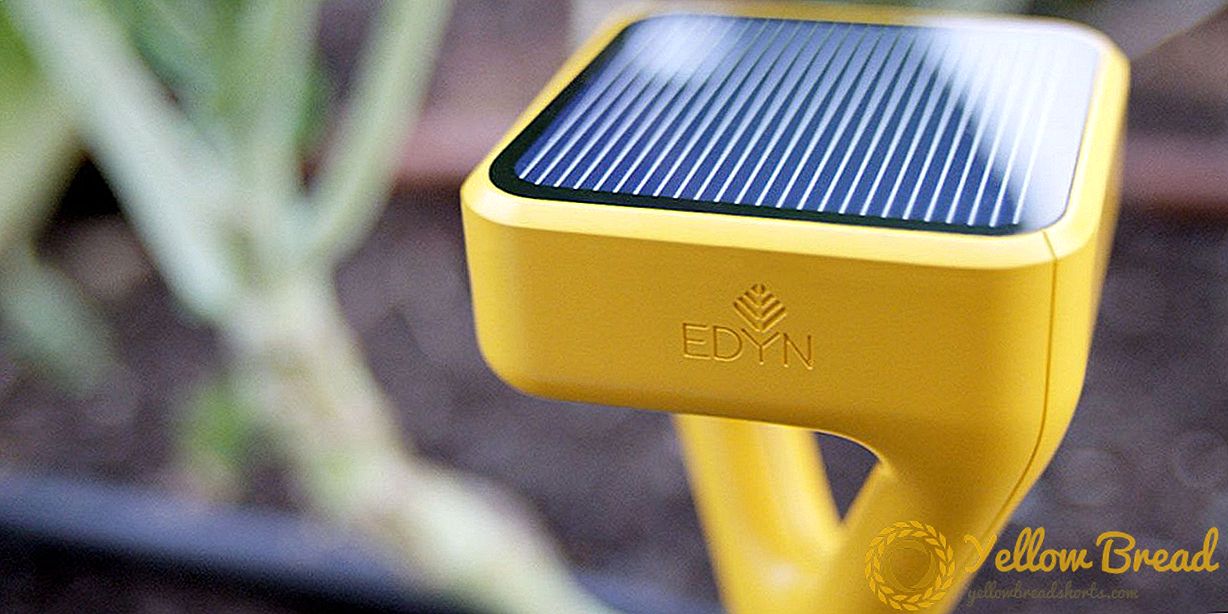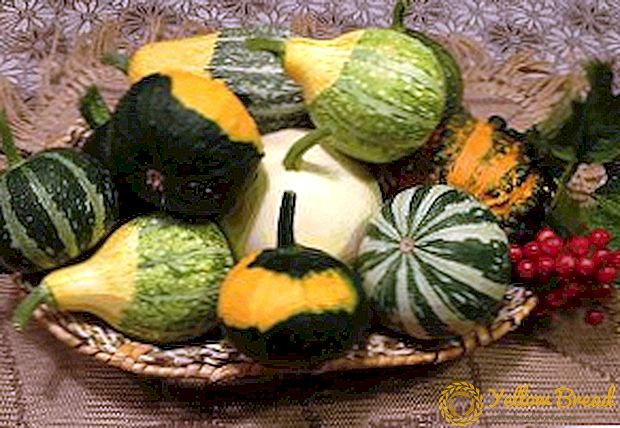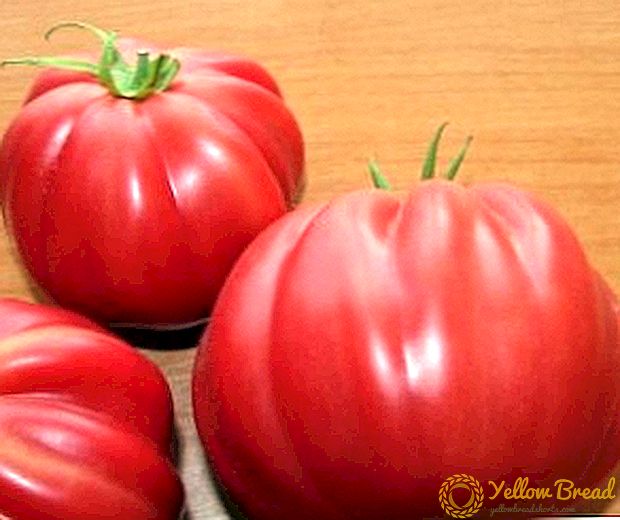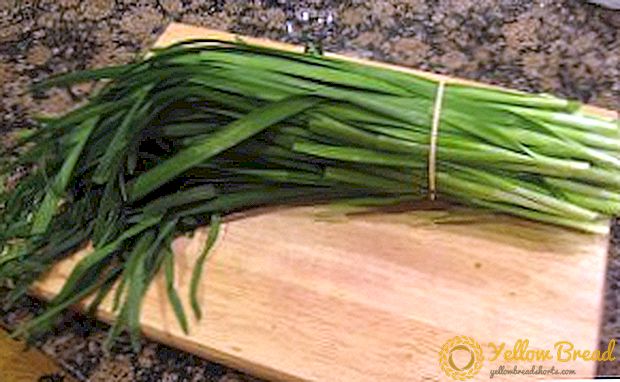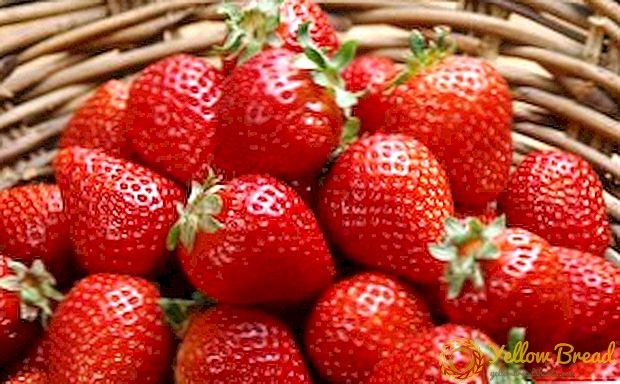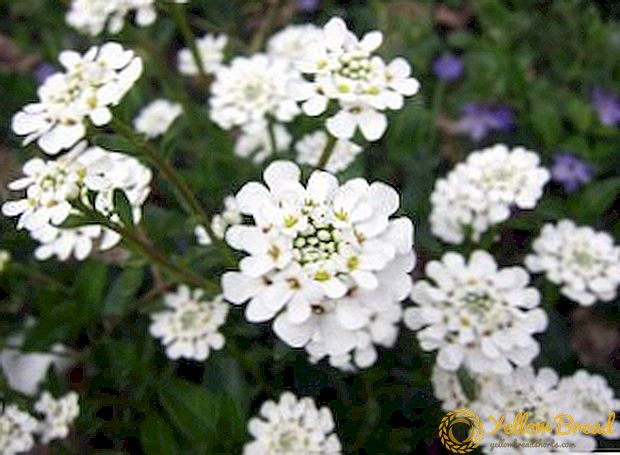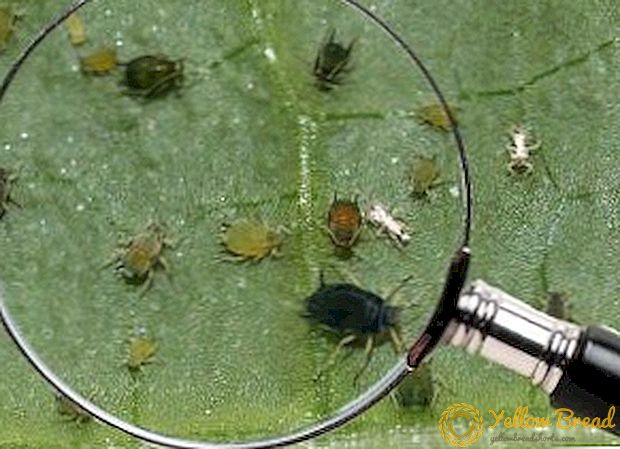 Aphid, perhaps, refers to one of the most common enemies of garden, garden and greenhouse crops. This dangerous insect is found almost everywhere, and the period of its malicious activity lasts throughout the season - from early spring to the most frost. The omnivorousness of the pest also strikes: the aphid with the same appetite destroys flowers, fruit trees, berries and vegetables.
Aphid, perhaps, refers to one of the most common enemies of garden, garden and greenhouse crops. This dangerous insect is found almost everywhere, and the period of its malicious activity lasts throughout the season - from early spring to the most frost. The omnivorousness of the pest also strikes: the aphid with the same appetite destroys flowers, fruit trees, berries and vegetables.
- Aphid: description of insect
- Aphid on fruit trees, what are the consequences
- Aphids in the trees in the garden: how to deal with the pest
- Biological ways of dealing with aphids in trees
- Chemical ways to protect the garden from aphids
- How to protect fruit trees from aphids folk remedies
- Aphids on fruit trees: prevention tips
As a result of the activity of this small bloodsucker, a violation of the life cycle of a plant occurs: it stops growing, loses flowers and ovaries, leaf tissue and shoots are deformed. In addition, sticky wastes of aphids, which remain on the leaves and stalk plates, are a favorable environment for the development of various fungal diseases, as a result of which the culture is polluted, photosynthesis processes are disturbed and the plant can die.  Finally, aphid itself is a peddler of various viral diseases: moving from an infected plant to a healthy one and bringing viruses directly into the tissue when sucking juice out of it, the insect promotes the spread of infection on bushes and trees, like a person infected with the flu, who actively sneezes in a crowded public transport.
Finally, aphid itself is a peddler of various viral diseases: moving from an infected plant to a healthy one and bringing viruses directly into the tissue when sucking juice out of it, the insect promotes the spread of infection on bushes and trees, like a person infected with the flu, who actively sneezes in a crowded public transport.
Aphid: description of insect
Aphid is a tiny insect, perceived by the naked eye as a dark dot of 0.5 mm in size (however, some species of aphids reach 7 mm in length). In fact, this miniature bloodsucker looks like a rounded shrimp or a drop. Insect can be both wingless and wingedIn the latter case, the aphid flying organs are represented by two pairs of transparent wings: longer front and shorter rear ones.
Shades of aphids are very different - these insects can be black, green, gray, red, pink and even transparent. The same species may change color as it grows, in addition, the color of the insect depends on the food it uses.  Wingless aphid is not able to move for long distances, such an insect spends most of its life within a limited area, using long legs moving within one or several plants.
Wingless aphid is not able to move for long distances, such an insect spends most of its life within a limited area, using long legs moving within one or several plants.
It becomes a winged aphid when the size of a colony grows so much that there is nothing for the insects to feed on within the nearest territory. Such winged individuals fly over to a new territory and form there another colony of pests.
A pupa does not form in aphids, live insects appear either from hibernating eggs, or directly born to an adult individual (and often the aphid cub is born already pregnant).
Aphid on fruit trees, what are the consequences
Aphid can cause harm to the orchard, the scale of which is absolutely incomparable with the tiny size of the pest itself. By forming colonies on the inside of the leaves,insects have been able to remain unnoticed for some time, as a result of which, after the pests have been detected, it is necessary to fight with aphids on infected fruit trees by radical methods.  In addition to sucking the juice from buds, leaves, young shoots, buds and flowers, aphid releases poisonous to the fruit tree. As a result, depending on the period at which the infection occurred, the buds fall off, the leaves twist into tubes and die, the buds, if they have not yet opened, simply fall off, the flowers become similar to lace napkins, the ovary does not form after such a deformation.
In addition to sucking the juice from buds, leaves, young shoots, buds and flowers, aphid releases poisonous to the fruit tree. As a result, depending on the period at which the infection occurred, the buds fall off, the leaves twist into tubes and die, the buds, if they have not yet opened, simply fall off, the flowers become similar to lace napkins, the ovary does not form after such a deformation.
If the fight against aphids on such fruit trees is not carried out, they can stop developing altogether.
About the excretions left by the aphids on the leaves, as a result of which the process of photosynthesis is suspended, and the tree is exposed to infection by a fungus, it has already been mentioned above. The danger of aphids for fruit trees is also caused by the fact that young shoots, the juices of which the pest especially likes to eat, become so weak that they are not able to survive even a not too severe winter.  Finally, a tree affected by aphids loses its overall ability to resist various diseases and other pests.
Finally, a tree affected by aphids loses its overall ability to resist various diseases and other pests.
There are separate species of aphids, which form entire growths on the branches of trees — galls. Ulcers that, due to such tumors, affect the branches of a tree, can completely kill it.
Aphids in the trees in the garden: how to deal with the pest
There are many types of aphids, which can only be distinguished from one another by a professional scientist. Fortunately, such personification, in general, is not required, since the aphid remedies on fruit trees are excellent for any representatives of this insect.  There are several different ways to deal with aphids: mechanical, biological, chemical, preventive. How specifically to get rid of aphids in trees depends on the gardener's personal preferences, the extent of damage, as well as the period when the aphid settled on the tree (budding, flowering, formation of ovaries, the beginning or end of fruiting).
There are several different ways to deal with aphids: mechanical, biological, chemical, preventive. How specifically to get rid of aphids in trees depends on the gardener's personal preferences, the extent of damage, as well as the period when the aphid settled on the tree (budding, flowering, formation of ovaries, the beginning or end of fruiting).
Biological ways of dealing with aphids in trees
In nature, aphids have both helpers and enemies. It is well known that the best remedy for aphids in the trees - ladybug.
Other nurses of fruit trees are, for example, flower flies (the popular name is hoverfly), fleece (golden-eyed) and some other insects, as well as birds. Helpers in the fight against aphids can be considered red ants. They do not feed on the aphids themselves, but they destroy black earth ants, which, in turn, are not only peddlers, but also natural defenders of aphids.  It is obvious that such insects and birds should be attracted in every way to your garden, or at least to avoid actions that can drive away the natural enemies of aphids. All of these beneficial insects overwinter in dry grass and dead leaves, therefore, by burning such organic matter in the fall, gardeners thereby destroy their "friends."
It is obvious that such insects and birds should be attracted in every way to your garden, or at least to avoid actions that can drive away the natural enemies of aphids. All of these beneficial insects overwinter in dry grass and dead leaves, therefore, by burning such organic matter in the fall, gardeners thereby destroy their "friends."
To make the garden seem attractive to ladybugs, you can use some tricks: for example,you should plant tansy, nettle, dill, yarrow, daisies and other plants that like these elegant red speckled bugs between fruit trees.  It is also recommended to take care of wintering for the ladybirds: for this you need not to burn, but, on the contrary, leave bunches of dry grass in the corner of the garden, ideally - corn tops. Some even find time to build tiny houses for useful insects - something akin to birdhouses, only much smaller.
It is also recommended to take care of wintering for the ladybirds: for this you need not to burn, but, on the contrary, leave bunches of dry grass in the corner of the garden, ideally - corn tops. Some even find time to build tiny houses for useful insects - something akin to birdhouses, only much smaller.
It is even easier for this purpose to twist the tube of cardboard, compacted with grass or other materials at one end and placed in the garden among the dry leaves.
Quite an ingenious way to make ladybirds in the garden is to simply buy a package with bugs in a specialty store (insects, indeed, are sometimes specially bred for sale).
The "reverse" method of dealing with aphids by biological methods is planting plants in the garden that the aphid itself does not tolerate. For example, henbane, basil, various types of elderberry, tobacco, dandelion, sorrel, horseradish, onion, garlic, mustard, wormwood, tansy and yarrow.From the colors of ala, I don’t like the smell of buttercups, marigolds, dandelions, chernobrivtsev (marigolds), chamomile, from vegetables - bitter pepper, potatoes, tomatoes.  Some of these plants can be used as a basis for spraying trees already affected by aphids. For example, it is recommended to chop the wormwood stalks with a knife or shears, pour boiling water and insist for several hours. After that, strain, add a little bit of any soapy substance to better keep the liquid on the leaf plate, and generously spray the trees, paying particular attention to the back of the leaves.
Some of these plants can be used as a basis for spraying trees already affected by aphids. For example, it is recommended to chop the wormwood stalks with a knife or shears, pour boiling water and insist for several hours. After that, strain, add a little bit of any soapy substance to better keep the liquid on the leaf plate, and generously spray the trees, paying particular attention to the back of the leaves.
Solution consumption per adult tree is about five liters. Aphid preparations on fruit trees can be independently manufactured in a similar way using tobacco leaves, onion peel, chopped garlic, inflorescences and chamomile stalks, dandelion leaves and roots, horse sorrel, fruits of hot peppers, celandine stems, pine needles, peel of any citrus fruits , potato or tomato tops, etc.  When spraying such plant broths and infusions, it is necessary to follow some precautionary rules.First, a high concentration of the active substance or spraying in the daytime in bright sunlight can lead to the formation of burns on the leaves.
When spraying such plant broths and infusions, it is necessary to follow some precautionary rules.First, a high concentration of the active substance or spraying in the daytime in bright sunlight can lead to the formation of burns on the leaves.
Secondly, some plants are destructive not only for aphids, but also for its natural enemies, moreover, a person can get poisoned during the procedure.
In any case, spraying should be carried out in a protective mask and gloves and not resort to this method of dealing with aphids during the fruiting period and at least two weeks (or better - not less than a month) before harvesting. 
Chemical ways to protect the garden from aphids
As practice shows, it is possible to destroy aphids in the trees without the use of toxic chemicals. However, in particularly difficult cases, chemical intervention may still be required.
When choosing what to use to destroy the aphids on fruit, it should be borne in mind that unlike many other pests, the aphid has a not too thick shell, so getting rid of it is quite easy with the help of any chemical preparation. Based on this, You should not resort to very heavy poisons.  It is recommended to stop the attention on preparations containing esters. Excellent helps to get rid of aphids made on a natural basis (flax and olives) insecticidal black soap. Also well proven drugs such as fufanon and Intavir.
It is recommended to stop the attention on preparations containing esters. Excellent helps to get rid of aphids made on a natural basis (flax and olives) insecticidal black soap. Also well proven drugs such as fufanon and Intavir.
It is equally important to choose the right time and method of processing. It is best to carry out the first spraying of trees before leafing.
Further procedures depend on the degree of contamination and the gardener's attitude to the use of chemicals. In general, no more than three sprays are carried out per season, but the latter, just as with the use of natural poisons, cannot be carried out later than three weeks before harvesting.
If the pests are already visible on the foliage, the treatment is carried out by contact: this allows the insect to be killed by direct external influence on it.The negative side of this method is that its effectiveness depends on precipitation (any unexpected rain can negate all the efforts of the gardener), as well as on the thoroughness of treatment (the poison kills only the pest with which it directly contacts).  Since the aphid often hides not just on the back of the leaves, but also inside the tube in which they are twisted, the contact processing method does not allow to achieve the goal. Help in this case can come systemic insecticides, which penetrate the sap of the plant and kill the aphids that feed on them from the inside. This method is also good because the tree quickly absorbs poison into itself, and rain cannot prevent the effective destruction of the pest.
Since the aphid often hides not just on the back of the leaves, but also inside the tube in which they are twisted, the contact processing method does not allow to achieve the goal. Help in this case can come systemic insecticides, which penetrate the sap of the plant and kill the aphids that feed on them from the inside. This method is also good because the tree quickly absorbs poison into itself, and rain cannot prevent the effective destruction of the pest.
Nevertheless, it should be noted that any precautions when working with pesticides can not fully ensure their point action, aimed only at one insect. Any drug has its side effects, negatively affecting other living organisms, including humans. Therefore, to resort to chemical protection against aphids should still in extreme cases.
How to protect fruit trees from aphids folk remedies
In addition to mechanical protection (washing off with water or shaking off hands) and spraying with plant decoction, a common aphid protection is watering the leaves with infusions of ash, soap solutions (household, liquid or tar soap is used), as well as soda solutions and birch tar.
For spraying fruit trees with similar folk remedies for 10 liters of water, 300 g of ashes are needed (for better dissolution, the ashes with water are boiled for about half an hour); 100 g of tar, 300 g of household soap or 125 ml of liquid soap. Some gardeners recommend quite original ways to get rid of aphids. In particular, it is claimed that the pest dies if the tree is sprayed with vodka or Coca-Cola, sunflower oil solution (1 tbsp per 10 l of water), as well as water mixed with cream (1.5 tbsp per bucket of water) and ethereal cedar, tea tree and lavender oils (about 50 drops each in a bucket of water).
Another popular remedy for aphids on fruit trees is fumigation with tobacco (a small fire is made of chips in a can, sprinkled with tobacco dust on top and when thick white smoke begins to fall from the can, put it under the tree).Some authors offer even more creative versions of fumigation - for this they use burning rubber, various wipers, etc.  It is possible that the aphids will not be delighted that she was poured with vodka and Coca-Cola and fumigated with burning tires, however, I think such a radical way can help get rid not only of aphids, but also from neighbors and households (yes and vodka in the household can be found more appropriate use).
It is possible that the aphids will not be delighted that she was poured with vodka and Coca-Cola and fumigated with burning tires, however, I think such a radical way can help get rid not only of aphids, but also from neighbors and households (yes and vodka in the household can be found more appropriate use).
Therefore, it is recommended to use less radical methods for pest control, the main of which, of course, is prevention.
Aphids on fruit trees: prevention tips
In order to understand how to prevent the lamb in the garden, you need to find out where it comes from.
A person can bring a pest to a plot along with those that have been acquired in untested places and which have not been sufficiently studied for the absence of signs of infection by plants. In addition, insects massively penetrate the garden if untreated fruit trees grow nearby (for example, from a nearby abandoned site).  The main aphid peddler is the aforementioned black earth ants.These insects are not only peddlers, but also natural defenders of aphids from other parasites, moreover, they even “allow” them to spend the winter comfortably inside the anthill. Such a "friendship" is explained simply: ants feed on the honeydew emitted by the aphids, so that the relationships between insects are built on a completely mutually beneficial basis.
The main aphid peddler is the aforementioned black earth ants.These insects are not only peddlers, but also natural defenders of aphids from other parasites, moreover, they even “allow” them to spend the winter comfortably inside the anthill. Such a "friendship" is explained simply: ants feed on the honeydew emitted by the aphids, so that the relationships between insects are built on a completely mutually beneficial basis.
Understanding these features, it is easier to avoid creating favorable conditions for the spread of aphids in the garden.
First of all, while treating your own garden from aphids, it is necessary at the same time (if possible) to spray unclean trees in the neighborhood, and also not to forget about your own lawn on which the pest can also settle.
When mowing the grass, it is recommended to leave blooming cornflowers, a shepherd's bag, wild carrots. These plants actively attract predators - natural enemies of aphids.  It is equally important for ants to block access to fruit trees. To do this, you need to get rid of the entire colony, and not to fight individual instances.
It is equally important for ants to block access to fruit trees. To do this, you need to get rid of the entire colony, and not to fight individual instances.
Since black ants live in the ground, digging up the nest and treating it with poison is a good way to expel them from the plot (you can use antimole, carbolic acid, kerosene, formalin, etc.).
Some advise sprinkling a tree around the circumference with a mixture of sawdust with grated pepper, garlic or tomato leaves (it is believed that ants do not like to crawl through such obstacles), however, it seems to be more effective to direct efforts to completely expel ants trees
In general, it has been observed that the feed connection between ants and aphids is so stable that it can be assumed that the formula is valid: ants will leave - and aphids will leave.

